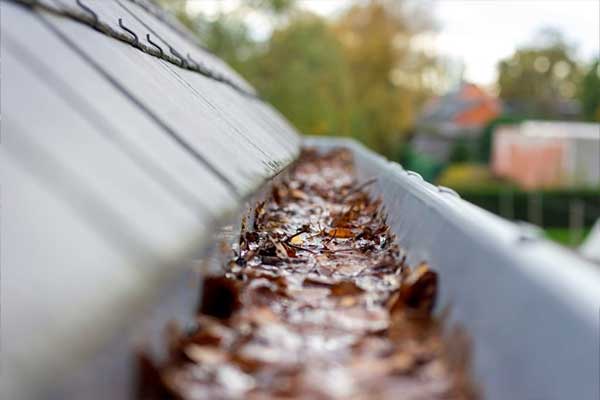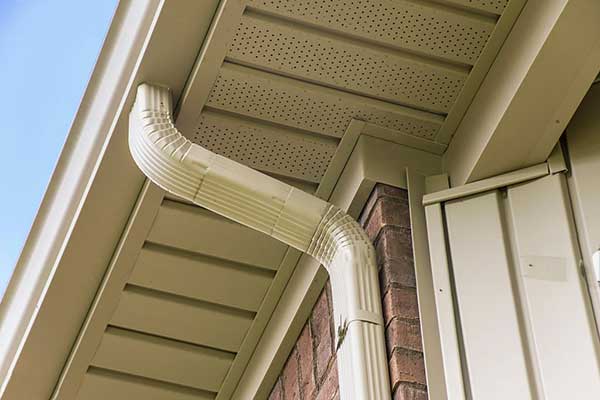To repair sagging gutters involves a systematic approach to restore functionality and prevent water damage. Begin by identifying signs of sagging, such as visible bowing or water overflow. Gather necessary tools, including a sturdy ladder, hammer, and level. Prioritize safety with proper ladder placement and protective gear. Clean the gutters thoroughly, removing debris and inspecting for damage. Adjust the gutter slope to maintain a 1/4 inch drop per 10 feet for ideal drainage. Reinforce weak sections with additional brackets, typically spaced every 2-3 feet. Seal leaks and fix joints using waterproof sealant. Regular maintenance is essential to prevent future sagging issues. The following steps provide a comprehensive guide to gutter repair.
Identifying Signs of Sagging Gutters
With a keen eye for detail, homeowners can identify several telltale signs of sagging gutters before they lead to more severe structural issues. The most apparent indicator is the visible deviation from the intended straight line, manifesting as bowed, cracked, or bent sections along the gutter system. During rainfall, water overflow from gutters is a clear sign of potential sagging or blockage, necessitating immediate attention.
Another vital indicator is pooling water around the foundation, signifying that the gutters are not effectively directing water away from the home. This can lead to significant structural damage if left unaddressed. Detached gutters or those pulling away from the fascia often result from warped hangers, indicating a need for prompt inspection and repair.
Perhaps the most concerning sign of gutter problems is water intrusion into basements or ceilings. This suggests severe sagging and improper drainage, potentially causing extensive damage to the home’s interior. Homeowners should regularly inspect their gutters for these signs of sagging, ensuring proper drainage and addressing any issues promptly to maintain the structural integrity of their property.
Gathering Necessary Tools and Materials
After identifying signs of sagging gutters, the next step is to gather the necessary tools and materials for repair. Essential tools include a sturdy ladder for safe access, a hammer for securing fasteners, and a power drill for installing screws and brackets. A level is vital to guarantee proper gutter slope, aiming for a 1/4 inch drop per 10 feet to facilitate drainage.
Key materials for the repair process include gutter screws for secure attachment, waterproof caulk for sealing leaks, and gutter spikes for additional support. Safety gear, such as gloves and goggles, is imperative to protect against sharp debris and potential tool-related injuries.
Based on the initial inspection findings, additional materials may be necessary. These could include new brackets or hangers to reinforce sagging sections of gutters. It’s important to assemble all required components before commencing work to guarantee a smooth and efficient repair process.
Safety Precautions for Gutter Repair
Safety stands paramount when undertaking gutter repairs, as working at heights poses inherent risks. When approaching this task, it is imperative to use a sturdy ladder appropriate for the height of your gutters, guaranteeing it can support both your weight and any necessary tools. Always maintain three points of contact while climbing the ladder, using either two hands and one foot or two feet and one hand to guarantee stability and balance.
Before setting up the ladder, inspect the ground for potential hazards such as mud or uneven surfaces that could lead to instability. Wear safety goggles to protect your eyes from falling debris and gloves to safeguard your hands from sharp objects encountered during gutter repairs. These protective measures are vital for minimizing the risk of injury.
If you feel uncomfortable working at heights or lack experience in gutter repairs, it is advisable to ask for assistance from a friend or consider hiring a professional. This precaution can significantly reduce the likelihood of accidents and guarantee the job is completed safely and effectively. By adhering to these safety guidelines, you can minimize risks associated with gutter repair work and maintain a secure working environment.
Cleaning and Inspecting Gutter Systems

Before starting on any gutter repair, a thorough cleaning and inspection of the gutter system is vital. Begin by setting up a sturdy ladder on level ground to safely access the gutters. Using a scoop or trowel, remove debris such as leaves, twigs, and dirt from the gutters. This step is important for preventing drainage issues and identifying potential problems.
After debris removal, flush the gutters with water to check for proper drainage and clear any remaining small particles. During this process, inspect the gutters for signs of rust, cracks, or sagging. Note any areas that require repair or additional support.
To maintain the integrity of your gutter system:
- Clean your gutters regularly to prevent buildup
- Inspect the gutters for damage during each cleaning
- Remove debris thoroughly to guarantee proper water flow
- Flush the gutters to identify and address any blockages
- Check for proper drainage and repair sagging gutters promptly
Adjusting Gutter Slope and Alignment
Proper gutter slope and alignment are essential for preventing sagging and guaranteeing efficient water drainage. The recommended gutter slope is approximately 1/4 inch for every 10 feet, which facilitates ideal water flow and prevents pooling issues. To achieve this precise gradient, adjusting gutter slope may be necessary.
Begin by loosening the brackets that secure the gutters to the fascia board. This allows for repositioning the gutters to achieve the correct angle. Utilize a level to accurately measure and confirm the slope, verifying it meets the recommended 1/4 inch per 10 feet guideline. Once the proper angle is established, re-tighten the brackets securely to maintain the adjusted position.
After completing the slope adjustment, it is vital to test the drainage by running water through the gutters. This step verifies that water flows freely without pooling or overflowing. Regular inspections of gutter alignment are important to identify and address slope issues early, preventing more significant sagging problems over time. By maintaining proper gutter slope and alignment through periodic adjustments and inspections, homeowners can guarantee their gutter system functions efficiently and prevents potential water damage to their property.
Replacing Damaged Gutter Hangers
Gutter hangers form the backbone of a functional gutter system, providing essential support and maintaining proper alignment. When gutters begin to sag, replacing damaged hangers is often a vital step in the repair process. To address this issue effectively, follow these steps:
- Inspect existing hangers for signs of rust, cracks, or looseness
- Remove old hangers using a screwdriver or drill, extracting all screws
- Position new hangers securely under the gutter, spaced 2-3 feet apart
- Tighten fasteners firmly without overtightening to prevent gutter damage
- Check gutter alignment and slope after installation
Begin by thoroughly examining the current hangers to identify those requiring replacement. Once identified, carefully remove the damaged hangers, confirming all screws are fully extracted. Install new hangers, positioning them securely beneath the gutter at intervals of 2-3 feet to provide adequate support. When fastening the new hangers, tighten screws firmly but avoid excessive force that could crack the gutter material. After installation, verify the gutters’ alignment and slope to guarantee proper water drainage away from your home. This methodical approach to replacing damaged gutter hangers will effectively address sagging issues and restore your gutter system’s functionality, protecting your home from water-related damage.
Reinforcing Weak Gutter Sections
Identifying weak spots in gutter sections is essential for effective reinforcement. A thorough inspection should focus on areas prone to sagging, particularly long runs and corners. Installing additional support brackets at strategic points along the gutter system can significantly improve its structural integrity and prevent future sagging issues.
Identify Weak Spots
Vigilant inspection is the first step in reinforcing weak gutter sections. To identify the cause of sagging gutters, assess the following key areas:
- Visible signs of bowing or bending
- Spacing of gutter hangers
- Condition of fasteners
- Gutter slope
- Need for additional supports
Begin by examining the gutters for any visible deformations, which indicate weak points requiring reinforcement. Next, check the positioning of gutter hangers, confirming they are spaced every 2 to 3 feet for ideal support. Inspect fasteners for damage or looseness, as replacing these can significantly improve structural integrity.
Evaluate the gutter slope, confirming a minimum drop of 1/4 inch per 10 feet to maintain proper drainage and reduce strain on vulnerable areas. Consider installing additional supports, such as gutter brackets or straps, at identified weak points to boost overall stability.
Regular maintenance and proactive identification of weak spots are essential for preventing extensive damage and costly repairs. By addressing these issues promptly, homeowners can extend the lifespan of their gutter system and guarantee its continued effectiveness in protecting their property from water damage.
Add Support Brackets
Once weak spots have been identified, the next step in reinforcing sagging gutters involves adding support brackets. To effectively prevent sagging and guarantee proper weight distribution, install additional support brackets every 2-3 feet along the affected sections. Choose sturdy U-shaped brackets designed to hold the gutter securely against the fascia board, making sure they are evenly spaced for ideal support.
When installing the new brackets, use a power drill to securely fasten them into the fascia. Exercise caution to avoid over-tightening, as this can potentially crack the gutter material. It is essential to assess the condition of existing brackets and replace any damaged or rusted ones to maintain overall gutter integrity.
During the installation process, focus on achieving consistent spacing and alignment of the brackets. This uniformity will contribute to the system’s stability and longevity. After installation, conduct a thorough inspection to guarantee all brackets are properly secured and aligned.
To preserve the effectiveness of this repair, incorporate bracket inspection and tightening into your regular maintenance routine. This proactive approach will help prevent future sagging issues caused by loose fittings and maintain the structural integrity of your gutter system.
Sealing Leaks and Fixing Joints
Effective sealing of leaks and proper fixing of joints are essential steps in maintaining a functional gutter system. To address these issues, utilize waterproof outdoor caulk or gutter sealant, applying generously to affected areas for a watertight bond. Inspect joints between gutter sections for gaps or separation, using a caulking gun to fill visible cracks or holes. For severely damaged joints, consider employing a gutter patching kit, which includes a durable patch and adhesive for a long-lasting seal.
Before applying any sealant, verify surfaces are clean and dry to maximize adhesion and effectiveness. Regularly inspect sealed joints for signs of wear or deterioration, reapplying sealant as needed to maintain the integrity of your gutter system.
Key steps for sealing leaks and fixing joints:
- Clean and dry affected areas thoroughly
- Apply waterproof outdoor caulk or gutter sealant generously
- Use a caulking gun to fill visible cracks and holes
- Employ gutter patching kits for severely damaged joints
- Conduct regular inspections and maintenance of sealed areas
Installing Additional Support Brackets
Installing additional support brackets is an important step in addressing sagging gutters and guaranteeing their long-term stability. These brackets play a vital role in distributing the weight of the gutter more evenly, particularly in areas prone to debris accumulation or heavy rainfall. To prevent sagging and maintain a properly sloped gutter system, brackets should be spaced every 2 to 3 feet along the length of the gutter.
When installing additional support brackets, opt for metal components rather than plastic ones to improve durability and resistance to bending under weight. Secure the brackets firmly to the fascia board using appropriate screws to prevent loosening over time. This installation method guarantees that the brackets can effectively distribute weight and support the gutter system.
Regular maintenance is essential for peak performance. Periodically check and adjust the positioning of these support brackets to maintain a proper slope of 1/4 inch for every 10 feet of gutter. This slope is important for effective drainage and prevents water from pooling in the gutters. By implementing these measures, homeowners can significantly extend the lifespan of their gutter system and minimize the risk of future sagging issues.
Preventive Maintenance for Future Issues
Diligence in preventive maintenance is essential for avoiding future gutter issues and extending the lifespan of your gutter system. Implementing a proactive approach to gutter care can significantly reduce the need for repairing sagging gutters and prevent water damage to your home’s foundation and exterior.
To prevent future problems and address common causes of gutter failure, adhere to the following maintenance practices:
- Regularly clean gutters at least twice annually to prevent debris accumulation
- Inspect gutters for damage or sagging every season, especially after severe weather
- Install gutter guards to minimize debris buildup and reduce cleaning frequency
- Guarantee proper gutter slope of ¼ inch per 10 feet for effective drainage
- Monitor nearby trees and trim overhanging branches to reduce debris accumulation
Clogged gutters are a primary cause of sagging and water overflow. Gutter guard installation can significantly reduce this risk. When you install gutter guards, you create a barrier that allows water to flow while preventing leaves and debris from entering the system. This not only reduces the frequency of cleaning but also helps maintain the structural integrity of your gutters. By adhering to these preventive measures, you can minimize the likelihood of future gutter issues and maintain peak performance.
Frequently Asked Questions
How to Fix Saggy Gutters?
To address saggy gutters, begin with thorough gutter cleaning to prevent water damage and drainage issues. Inspect and tighten loose hangers, replacing damaged ones as needed. Adjust the gutter slope for proper water flow. If problems persist, add support brackets every 2-3 feet. Regular seasonal checks and DIY solutions can prevent common problems. For severe cases, consult professionals about partial or complete replacement. Proper gutter maintenance and timely repairs are essential for effective home improvements and long-term protection against water-related issues.
How to Raise up a Gutter?
Ironically, raising a gutter is all about lowering your expectations of a simple DIY project. To lift your gutter, start by evaluating its pitch using gutter pitch adjustment techniques. Loosen brackets and adjust the slope, ensuring proper drainage solutions. Employ gutter repair tools to secure the newly positioned gutter. Implement regular seasonal gutter inspections and gutter cleaning methods to prevent future sagging. Consider gutter material options for longevity, and always prioritize gutter safety precautions during maintenance. This process addresses common gutter problems while enhancing overall gutter installation techniques.
How to Lift Guttering?
To lift guttering effectively, regular gutter maintenance is essential. Begin by clearing debris and inspecting for common problems like damaged hangers. Adjust the slope using installation tips for proper drainage solutions. Employ additional support brackets every 2-3 feet for stability. Utilize tools like levels and gutter spikes for precise adjustments. Perform seasonal checks to prevent future sagging. Consider material choices for longevity. When conducting DIY repairs, adhere to safety precautions, and follow cleaning advice to maintain peak gutter performance.
How to Fix Gutters Pulling Away From a House?
Coincidentally, addressing gutters pulling away from a house aligns with essential gutter maintenance tips and water drainage solutions. Begin by inspecting gutter hangers and fasteners, tightening or replacing as necessary. Guarantee proper slope for effective rainwater management. Perform seasonal gutter cleaning to prevent debris accumulation. For DIY gutter repair, install additional support brackets or gutter wedges. This approach not only resolves common gutter problems but also contributes to roof leak prevention and overall home exterior upkeep, enhancing your gutter installation’s longevity and efficiency.

